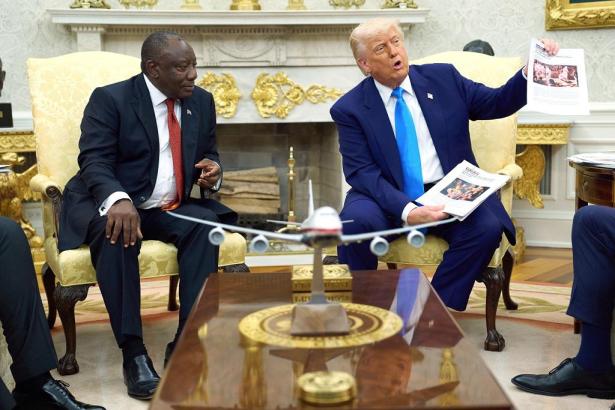Donald Trump and Elon Musk recently met with South African President Cyril Ramaphosa in the White House. Trump dimmed the lights and showed a video consisting of various right-wing propaganda products purporting to prove that white South Africans are being singled out for their race and killed en masse. It’s a “genocide,” Trump insisted. “They’re being executed, and they happen to be white, and most of them happen to be farmers. I don’t know how you explain that.”
“Death, death, death,” he added.
I can speak to the reality of the situation. I lived for two years in South Africa, right in the teeth of the terror, as a Peace Corps volunteer from 2009 to 2011. I made it through my two years of service through an astute and considered strategy of taking no precautions whatsoever against roving genocidal murder squads. To quote Peregrin Took from The Lord of the Rings: “The closer we are to danger, the further we are from harm.”
Accordingly, I lived with a Black host family in a remote village about 100 kilometers north of the city of Kuruman (where the famous Dr. Livingstone did missionary work in the 19th century) in Northern Cape province, and about 100 kilometers south of the border with Botswana. This was part of the former apartheid bantustan of Bophuthatswana, and as a result, I was the only white person in the entire village, and to my knowledge no other white people than other Peace Corps volunteers lived in an 80-kilometer radius. I would routinely go on hours-long runs down the local gravel roads, or hours-long walks up and down the neighboring creek bed, which was usually dry—all by myself.
This cunning strategy of hiding in plain sight and constantly wandering around in remote locations by myself where I could have been easily dispatched and left for the vultures worked brilliantly. The fact that every person in the village—indeed, probably most of the people in neighboring villages too—knew who I was and where I lived only added to my protection.
This also explains why Elon Musk is so obsessed with this subject. Given that he grew up as a cosseted scion of privilege in apartheid South Africa, going to all-white private schools and growing up in a large, heavily secured compound, waited on hand and foot by Black servants, he was actually in a lot more danger than someone wandering the bush and taking public transport by himself.
The nearest grocery store was in Kuruman, and since I did not have a car (my Peace Corps stipend amounted to about $350 a month) I rode the public bus to get there. Again, I was often the only white person in sight, on the bus and in the stores and at the crowded bus station.
Alas, the South Africa bus network is rather thin in the impoverished and depopulated hinterland of Northern Cape, so if I wanted to go east to Pretoria, I would often hitchhike to Vryburg, often riding in the bed of a “bakkie” (pickup) with several day laborers. (Pro tip for this situation: Put a bottle opener on your keychain in case someone wants to open a bottle of Carling Black Label at 7:00 in the morning; he’ll appreciate not having to use his teeth.) From there, I could catch a public taxi—typically a 22-passenger van—to Pretoria, again, often the only white face aboard.
The 2010 World Cup took place in South Africa, and so I joined some high school friends on a trip to see several games. (Since American tickets were out of reach price-wise, we decided to root for Ivory Coast.) We practically circled the whole country in a pitifully underpowered hatchback, mostly staying at public campsites.
Thanks to my genius foresight, not once did I encounter anything but polite courtesy from the Black folks constantly surrounding me on all sides, except for once when a criminal miscreant ran off with a pair of shoes I had just bought. If anything, people were rather protective, surprised to see a white face on the working-class transport system, making sure I knew where I was going and that I got there safely. No doubt they were just trying to get me to keep my guard down.
One might react to my story by concluding that this whole white genocide story is a racist lie cooked up by white supremacists in Europe and America. After all, even right-wing Afrikaner lobbying groups say it’s a delirious fantasy. One might add that while South Africa does have a very serious crime problem, it in no way resembles genocide, and in fact, white murder victims are underrepresented as a share of the population. One might further add that Ramaphosa’s cabinet has eight white members, one of whom was present at the White House, and one of the articles Trump waved around in the meeting was actually from the Democratic Republic of the Congo.
To which I reply: How dare you impugn the honor of our sagacious president Donald Trump? This man has never, ever, not once, regurgitated flagrant lying propaganda or crack-brained Facebook memes in public—especially not racist ones. If there’s anyone to trust for detailed knowledge about the inner workings of African countries, it’s this man.
===
Ryan Cooper is the Prospect’s managing editor, and author of ‘How Are You Going to Pay for That?: Smart Answers to the Dumbest Question in Politics.’ He was previously a national correspondent for The Week.


Spread the word